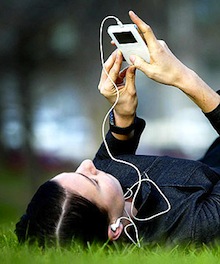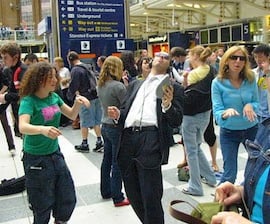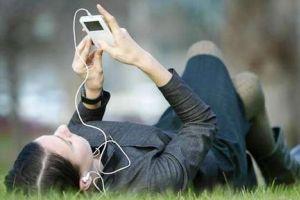To anyone who enjoys listening to music, it sounds like some sort of bad play on words for ears: The more you listen to music, the less you can actually hear. But this is not some unfortunate formula with which Boomer parents (“turn-that-garbage-down!”) used to scold their offspring. The aural tit-for-tat is an increasingly modern problem, and an equation that is growing exponentially for younger generations.
According to national health survey data from 2005 to 2008, reported in an article in the November issue of Journal Archives of Internal Medicine, one in five Americans age 12 and older have hearing loss — a much larger number than previous surveys showed. But what’s especially ear-opening, researchers say, is that it’s the way we listen to music that’s to blame. The first remedy is obvious: Turn down the volume. Yet the real prescription is more likely a fundamental rethinking of how we listen to music. That’s because the way we share music has completely shifted.

Sharing music, in essence, has become a more solitary experience. Listening to music used to be a communal happening. People gathered around and tuned in together, in a salon or concert hall, circling around a radio, or later passing around the latest CD cover and going through it song by song. Around the same time, we began to plug our ears to keep in the music, rather than to keep it out. Soon enough, we could all listen to music in public, but not with the people we were standing right next to. Today, as Daniel J. Levitin, a neuroscientist at McGill University and the author of This Is Your Brain on Music: The Science of a Human Obsession, noted: “The average 12-year-old can hold in her hand more songs than my great-grandfather would have heard in his entire lifetime. But kids these days are doing that on their iPods.” As he noted: “Plugging your ears isn’t exactly a come hither and share this with me gesture.” Sharing music today might simply mean “liking” a song someone is listening to on Spotify via Facebook, tagging someone on a video post, or burning an MP3 and emailing it: no human contact needed.
The Loudness Wars
And yet, wired into that trend is the fact that music has become louder and — what’s worse — more noisy, and in more ways than one. Pump Up the Volume is not just the name of a movie. Live music is played louder, and increasingly, it’s amplified. And for years in recording studios, it has been “the louder the better.” Modern technology only amps up the trend. Most people listen to their iPods at levels exceeding 95 to 100 decibels. That’s about the same loudness you’d hear standing on the tarmac as a 747 takes off. The National Institute for Occupational Safety and Health allows only eight hours a day of 85 decibels in the workplace (60 decibels is the level of normal conversation). Levels above that damage your hearing, and hearing loss is usually irreversible.

And then there’s the noise. Just before noise-canceling headphones became ubiquitous, the recording industry began adding actual noise — yes, noise — to our music, a distortion that enabled it to be played even louder than naturally possible.
Thus began the so-called Loudness Wars. Competition in the music industry led to a myth: In the race for airplay and record sales, producers and record companies became convinced the key was to make music as loud as possible. Pushing the absolute digital max, using heavy dynamic-range compression, could make their records stand out and sell more copies, they thought. (Dynamic range is the difference between the softest and loudest parts of a song.) The louder the music, the hotter the record. Never mind the distortion that results: The compression trick (which is actually loss of fidelity) makes it impossible to hear the noise any more.
Bob Ludwig, a record-mastering engineer who, for more than 40 years, has served as the “final ear” in the audio chain for albums ranging from Jimi Hendrix to Tony Bennett to the Kronos Quartet, told NPR: “The ‘Loudness Wars’ have gone back to the days of 45s. When I first got into the business and was doing a lot of vinyl disc cutting, one producer after another just wanted to have his 45 sound louder than the next guy’s so that when the program director at the Top 40 radio station was going through his stack of 45s to decide which two or three he was going to add that week, that the record would kind of jump out to the program director, aurally at least.”
iCan’t Hear You
Along came the iPod era, and more audio compression. The kind of compression used in recordings is the same digital process that allows a song to go from being a very big sound file in its natural state to a very small file in your iPod, enabling us to carry hundreds of songs in a portable musical library in our pockets. Survey data suggest that children and teens today will become dependent on hearing aids and implants much sooner than the generation before them, as a result of these kinds of hearing loss threats around us. A survey sponsored by the Australian government found that about 25 percent of people using portable stereos had daily noise exposures high enough to cause hearing damage. Further research from the Netherlands reports that 90 percent of adolescents listened to music through earphones on MP3 players, almost half used high-volume settings, and only 7 percent used a noise limiter.
It’s time to rethink how we can get people out of the solitary wilderness of the modern-day musical experience and back around the figurative communal musical fire.
Loss of hearing due to loud music was once termed “rock ’n’ roll deafness” and believed to be a major threat to the Baby Boomers growing up in the 1950s and 1960s. Those adults, however, will fare better than music listeners in the MTV and MP3 generations. Maybe it’s no surprise, then, that Apple has even been sued for hearing loss attributed to the iPod.
So who won the Loudness Wars? The better question might be: ”What?” If you can’t hear the forest or the trees, then it’s time to rethink how we can get people out of the solitary wilderness of the modern-day musical experience and back around the figurative communal musical fire, relearning how to hear and to listen.
Interactivity is the key. Private listening to music, for most people, has been around since Edison’s phonograph. Today’s challenge is getting people to reengage music as a public audience. An audience of listeners participates in a musical loop with the performers: Their reactions provide real-time data to which musicians, in turn, react. And now Internet-savvy musicians are finding innovative ways to reproduce that effect, using technology: Think about the YouTube Orchestra.
In a sense we should all play, well, together.
A new release by the artist Björk is one exciting concept in binding together musician and listeners in a common communication. As she notes, with regard to listening to music, “Things have changed around here.” Arguably one of the more innovative projects in popular culture, her new album, Biophilia, turns an album into an encompassing interactive experience that lets the listener control the basic components of the music, joining the listeners with the artists as active participants. The music on the album might not be, well, music to everyone’s ears, but it is an ambitious rethinking of how to make music relevant to the public. Björk’s hypothesis: “There is an instinctive bond between human beings and other living systems,” and in a sense we should all play, well, together.
Here, playing the music (say, once you download the album from iTunes onto your iPad) means not simply pressing “play” for the machine to play the song, but for you to actually play the song. The user is no longer merely a listener but rather part of the sound-creation. As one reviewer remarked, “So far the digital music revolution has meant a shift in the way we buy and store music, but the actual modality of simply listening to music has stayed the same. Instead the real musical revolution may be just the beginning: a revolution that changes the substance and practice of loving music.”
And if we're talking about a revolution, here's to being able to hear and listen, more, together.

